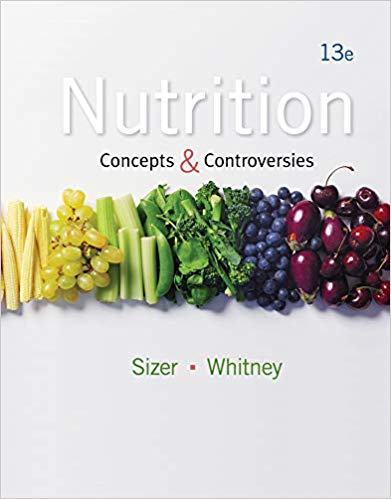Nutrition Now 7th Edition by Judith E. Brown – Test Bank
Test Bank for Unit 4 – Understanding Food and Nutrition Labels
True/False
1. _____ Cookies sold at a local bakery must have a Nutrition Facts panel on the package.
2. _____ The “radura” symbol on a food package indicates the food has been irradiated using x-rays, gamma rays, or electron beams.
3. _____ If a food is fortified with vitamins and minerals that are not a required nutrient to be labeled, information about these nutrients becomes mandated on the Nutrition Facts panel.
4. _____ Ingredients on a food label are listed in descending order according to the number of calories each ingredient contributes.
5. _____ Industry-initiated food labeling is voluntary, is based on science, and has been proven to help guide consumers to better food choices.
6. _____ The term organic is not regulated by the USDA or any other government agency for use on food packages.
7. _____ Foods that are organic cannot be produced using genetically modified seeds or irradiated.
8. _____ FDA-approved model health claims cannot be modified or abbreviated when placed on food labels.
9. _____ Dietary supplement packages do not include misleading structure/function claims because supplement labeling is highly regulated.
10. _____ The most common food additives are sugar and salt.
11. _____ The USDA requires retailers to display a country of origin label on meats, fish, fruits, vegetables, nuts, and some herbs.
Matching
Matching A: Match the term or image found on a food label with its meaning.
|
1. _____ “100% Organic” 2. _____ “Organic” 3. _____ “Made with Organic Ingredients” 4. _____ “Some Organic Ingredients” 5. _____ USDA Organic seal |
a. contains at least 95% organic ingredients b. all ingredients are entirely organic c. contains less than 70% organic ingredients d. contains at least 70% organic ingredients e. growers and producers are certified organic through the United States Department of Agriculture |
Matching B: Match the term with its description.
|
6. _____ structure/function claim 7. _____ dietary supplements 8. _____ enrichment 9. _____ food additives 10. _____ fortification 11. _____ % Daily Values |
a. the percentages of the standard nutrient amounts obtained from one serving of the food product b. statements on dietary supplement labels that describe the effect the supplements may have on the body c. the replacement of thiamin, riboflavin, niacin, and iron lost when grains are refined d. the addition of one or more vitamins and/or minerals to a food product e. substances added to food to enhance color, flavor, texture, cooking properties, shelf life, or nutrient content f. products taken by mouth such as amino acids, fish oils, vitamins, minerals, herbs, and plant extracts |
Multiple Choice: Choose the one best answer.
1. The standardized Daily Value for carbohydrates is _____ of total calories, and the Daily Value for fat is _____ of total calories.
a. 45%, 25%
b. 60%, 10%
c. 60%, 30%
d. 10%, 30%
2. Which statement regarding trends in nutrition labels is false?
a. Additional nutrition labeling has been implemented by some food companies.
b. Chain restaurants are now required to label menu items with calorie values.
c. ”Nutrition at a Glance” and “Smart Choices Made Easy” are voluntary labeling systems.
d. Health claims are now required on all products sold in a supermarket.
3. Which of the following statements about fortified foods is false?
a. Regular consumption of fortified foods may increase the risk of exceeding the Tolerable Upper Intake Levels of a specific nutrient.
b. Foods are often fortified to reduce the risk of chronic diseases such as osteoporosis, cancer, and heart disease.
c. Some foods are being fortified to enhance sales appeal.
d. Foods that are fortified do not have to list information about the amount of the nutrient(s) added to the food.
4. Which of the following foods is required to have a Nutrition Facts panel?
a. Apple turnovers sold at the local bakery
b. A box of breakfast cereal
c. Produce sold at farmers’ markets
d. A package of fresh shrimp sold at the supermarket
5. Which of the following products would not require a Nutrition Facts panel?
a. A dozen prepackaged doughnuts
b. Prepackaged deli meat
c. A bunch of broccoli
d. A can of green beans










